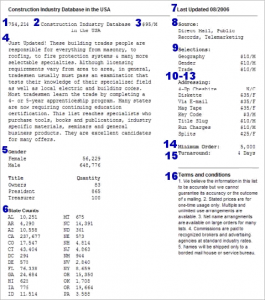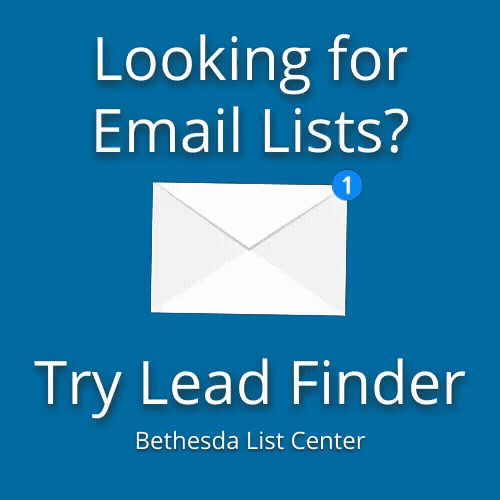How to Read a Data Card
In less than 30 seconds you can read any Mailing List Datacard like an expert!
Researching how to maxmize your ROI on direct marketing campaigns? Want to decipher the data card language and get a better understanding of exactly what that list has to offer your strategy? Bethesda List Center is here to help.
Using the sample Data Card below, learn what each item on a data card means and how it can help you create a stronger direct marketing campaign with better ROI results.
Deciphiring the Sample Data Card
Match the number on the datacard sample to the explanation keys below. For help or more information contact us at 301-986-1455.
Explanation Keys
1. Total quantity of names available for RENTAL.
In the list business, names are always rented for one time (or other agreed upon number of times) use, never sold out right.
2. Name of mailing list.
3. Base cost of the list.
Generally presented as $/M (cost per thousand names).
4. Basic information about the list (sometimes called “file” or “list property”).
While you’re reviewing this section, ask yourself “Are these the kinds of individuals who would be most interested in my product or service?”
5. Selects available.
Here’s your opportunity to dig deep and find just the right prospects for your message. Do you want just Windows NT users? Are you looking for prospects at companies with large sales volumes? This is how you find them.
6. State counts.
If you’re looking to mail by state or region, this is where you look.
7. Last updated.
How old is the file? Fresh updates generally offer better deliverability for your promotion.
8. Source.
How was the list developed, where did it come from? Subscribers? Conference Attendees? Software Buyers? Compiled from directories? Hint: Response names — people who have bought something, asked for something, attended something — can often produce a better response for your promotions. But they are had at a premium price. Word to the wise? Always test!
9. Number of selects available and their additional costs.
How narrowly or broadly you segment your list can greatly impact your response rates and costs. Remember, these costs are added to the base rates.
10. How do you want your names?
Formats vary from machine – affixable paper labels (cheshire) to pressure-sensitive or “sticky” labels to electronic (9-track/1600bpi magnetic reel tapes or ASCII comma delimited diskettes.)
11. Keycode for tracking.
Re-mail a winner, toss a loser when you code your lists and track their performance.
12. Running charges.
Costs incurred when you cancel a mailing list order before the mail date.
13. Splits.
Want to test two different prices to the same list? Split the file! For example, rent 10,000 names and ask BLC to run a 50/50 split — 5,000 names each. The cost is an extra $25 flat.
14. Minimum order.
The minimum number of names you are charged for even though you may not need that number of names.
15. Turnaround.How long it takes to get your list from the time your order is received, generally considered in “working” rather than calendar days.
16. Terms and conditions.
The small print governing the list manager’s payment, cancellation and other policies. Lists canceled after the mail date are due in full. If cancellation is received prior to mail date, running charges, shipping, and media (list format) charges apply.
Congratulations!
Now that you’re a data card expert, call and ask us for BLC’s best list recommendations for your next direct mail campaign!
301-986-1455


